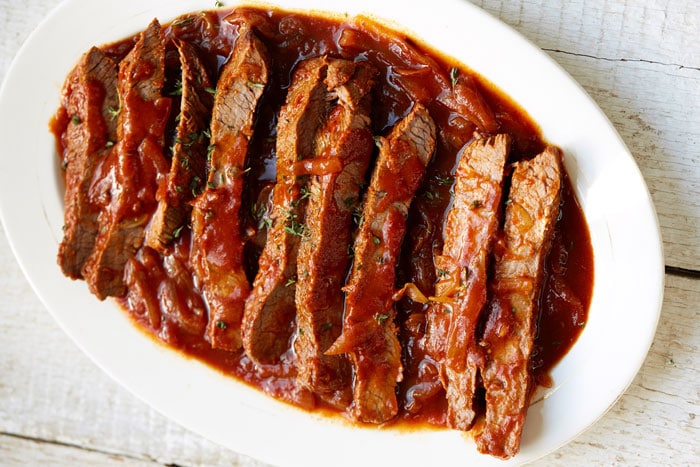 Robert Rosenthal’s Brisket
Robert Rosenthal’s Brisket Traditional food is the hub of any Jewish holiday, and you can’t get more traditional than brisket.
Brisket is particularly welcome at Passover for one simple reason: No bread? No problem.
“A Jewish feast without bread or breading or stuffing or noodles is hard to find,” Challah Guru Mandy Silverman of Mandylicious told the Journal. “Sweet noodle kugel, challah, bagels, babka [and] rugelach are all forbidden, but brisket is easy to prepare without any of those things. So you get a traditional Jewish dish that is warm and delicious, and can even be made ahead. That is gold.”
Silverman says brisket falls under the category of “Traditional Jewish Foods My Bubby Used to Make and One Day I Hope to be Able to Make Almost as Good as She Did.”
Silverman says brisket falls under the category of “Traditional Jewish Foods My Bubby Used to Make and One Day I Hope to be Able to Make Almost as Good as She Did.” While some may say the secret to making the perfect, moist brisket is to have someone else make it for you, Silverman is certain everyone can make an awesome brisket.
“I tend to treat brisket the way I used to treat challah,” she said. “That it is a sacred dish: complicated, time-consuming and, if you mess it up, it will be so sad.”
Sliverman said she used to overcomplicate her brisket. She read way too many recipes and, for the longest time, never felt that her brisket measured up. After being around the brisket block a few times, she said the two biggest things you need to do when making a brisket are:
• Use a fattier brisket. The “first cut” briskets often set you up for failure. They are not as fatty and therefore lead to a tougher, chewier brisket.
• Cook low and slow. When briskets are cooked on a low heat for a longer period of time, it makes them so soft, and the flavor gets all the way through. Plus, “you save a ton of money on air freshener because Eau de Brisket will permeate your home for a good long time.”
Silverman says her brisket is very forgiving. Because she makes it in a crockpot, there is no need to continually baste or check on it. You just throw everything in the crockpot and it is perfect every single time.
Silverman serves her brisket pulled. The meat can be served in a variety of nontraditional ways.

“I love serving it over mashed potatoes and doing a mashed potato brisket bowl, [on] a plain piece of matzah with a drizzle of horseradish mayo or, of course, just straight up,” she said. Her recipe “cannot be beat.”
Mandylicious’s Not Your Bubby’s Pulled BBQ Brisket
5 lb brisket (try to avoid first-cut briskets)
1 3/4 cup BBQ sauce
3 tablespoons dark brown sugar
1 tablespoon red wine vinegar
2 tsp seasoned salt
1 tsp garlic powder
1/2 tsp black pepper
1 tsp onion powder
1 large onion, sliced
Additional garlic powder and seasoned salt for sprinkling
Pat the brisket dry. Liberally season both sides of the brisket with garlic powder and seasoned salt. Place the sliced onions on the bottom of the crockpot. Place the brisket fat side up on top of the onions, mix together remaining ingredients and pour on top of brisket. Cook on low for nine to 11 hours or high for five to six. Let it cool completely. Remove from sauce.
It can be enjoyed as is with gravy on the side, or you can use two forks to gently pull the beef and ladle remaining gravy on top.
***
Chef Rob Rosenthal, AKA Short Order Dad, loves any holiday where food is the centerpiece. He said he also believes that brisket is “hard to screw up.” It can feed a lot of people, makes your house smell really good and is even better the next day.
“The secret is simple: a long leisurely braise in flavor-filled liquid that results in soft and succulent meat loaded with savory, oniony gravy,” Rosenthal, who “makes food fun” as a speaker, journalist, author, instructor and podcaster, told the Journal.
Kids and grownups alike will love his mouthwateringly delicious, fall-off-the-bone (even though there isn’t a bone), tender brisket.
Rosenthal’s extremely adaptable recipe transforms an ordinary piece of meat into an extraordinary meal.

Rob Rosenthal’s Braised Brisket of Beef
1 beef brisket (about 3 pounds)
2 garlic cloves, peeled and sliced thinly
1 tablespoon salt
Ground black pepper to taste
2 tablespoons vegetable oil
4 large onions, peeled and sliced
3 cups of beef or vegetable broth
10-ounce can crushed tomatoes or 1 small can tomato paste
½ teaspoon cayenne pepper or hot Hungarian paprika (optional, but nice if you like a little kick)
Pat the brisket dry. With the tip of a sharp knife, make slits on both sides of the meat and stuff with thin slices of garlic. The more you like garlic, the more slits you’ll make. Season each side very generously with 2/3 of the salt and pepper.
Place oil in a large, heavy bottomed pot over medium-high flame. When hot, brown the brisket on both sides, lowering heat as necessary so as not to burn. You’re looking for a nice brown color.
When browned, add broth, onions, remaining salt, tomato product and cayenne if you’re using it. There should be enough liquid to cover about 2/3 of the brisket. If you need more liquid, you can use more broth. Stir and bring mixture to boil, and then lower the flame so that broth remains “simmering”—that is, not vigorous, but still moving gently. Cover the pot. You can leave it on top of the stove or place in a 325-degree preheated oven.
Cook until meat is very tender but not totally falling apart, at least two hours. More is fine. Just make sure to check along the way to ensure that you still have sufficient liquid in the pot to partially cover the meat. Add more if necessary.
Remove brisket to a carving board and cover it with aluminum foil. Now look at the remaining oniony broth/gravy and decide if you like what you see or you would like it to be thicker. If there is a lot of liquid, you can reduce it considerably by putting it back on the stovetop, at a higher temperature, and cook until it reaches the consistency you desire. This can take a good 20 to 30 minutes if you have a lot of liquid in the pot. Taste and adjust seasoning, adding more salt or pepper if necessary. Then slice brisket against the grain and top with onion gravy.
Serve alongside something that will welcome all the sauce, like mashed potatoes, and some bagged salad greens with a sprinkle of olive oil, lemon and salt.
Note: Once you understand the basic technique of searing and braising, you can customize your own version with a variety of flavorful additions that excite you: cloves of garlic, herbs like thyme or rosemary, spices such as cumin, cinnamon or curry powder, dried apricots or carrots and parsnips added during the last hour of cooking. ■























 More news and opinions than at a Shabbat dinner, right in your inbox.
More news and opinions than at a Shabbat dinner, right in your inbox.